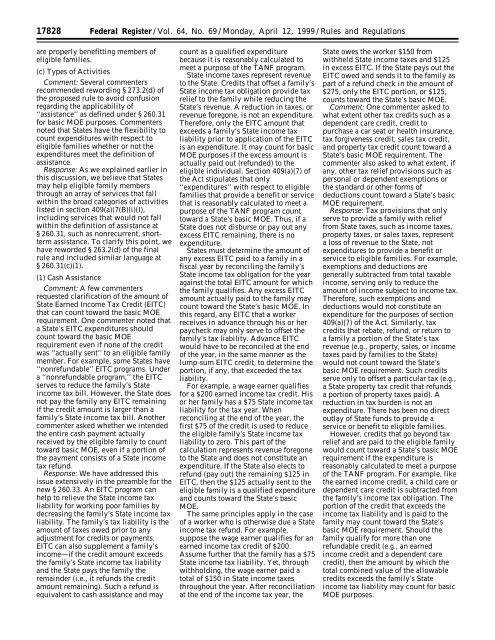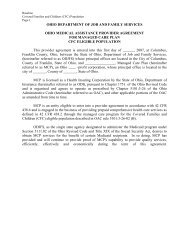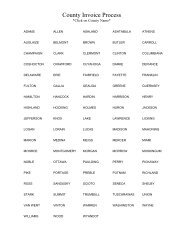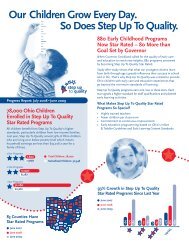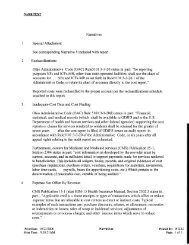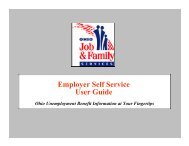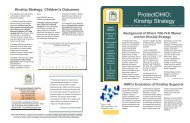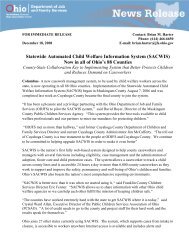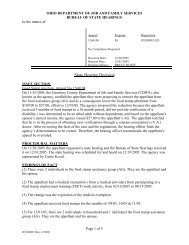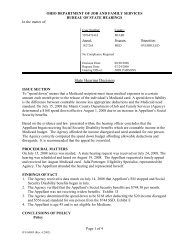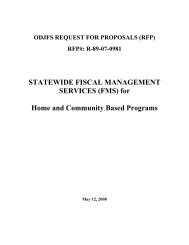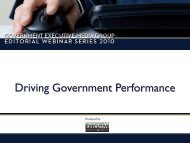Final TANF Rule as published in the Federal Register 4/12/1999
Final TANF Rule as published in the Federal Register 4/12/1999
Final TANF Rule as published in the Federal Register 4/12/1999
Create successful ePaper yourself
Turn your PDF publications into a flip-book with our unique Google optimized e-Paper software.
17828 <strong>Federal</strong> <strong>Register</strong> / Vol. 64, No. 69 / Monday, April <strong>12</strong>, <strong>1999</strong> / <strong>Rule</strong>s and Regulations<br />
are properly benefitt<strong>in</strong>g members of<br />
eligible families.<br />
(c) Types of Activities<br />
Comment: Several commenters<br />
recommended reword<strong>in</strong>g § 273.2(d) of<br />
<strong>the</strong> proposed rule to avoid confusion<br />
regard<strong>in</strong>g <strong>the</strong> applicability of<br />
‘‘<strong>as</strong>sistance’’ <strong>as</strong> def<strong>in</strong>ed under § 260.31<br />
for b<strong>as</strong>ic MOE purposes. Commenters<br />
noted that States have <strong>the</strong> flexibility to<br />
count expenditures with respect to<br />
eligible families whe<strong>the</strong>r or not <strong>the</strong><br />
expenditures meet <strong>the</strong> def<strong>in</strong>ition of<br />
<strong>as</strong>sistance.<br />
Response: As we expla<strong>in</strong>ed earlier <strong>in</strong><br />
this discussion, we believe that States<br />
may help eligible family members<br />
through an array of services that fall<br />
with<strong>in</strong> <strong>the</strong> broad categories of activities<br />
listed <strong>in</strong> section 409(a)(7(B)(i)(I),<br />
<strong>in</strong>clud<strong>in</strong>g services that would not fall<br />
with<strong>in</strong> <strong>the</strong> def<strong>in</strong>ition of <strong>as</strong>sistance at<br />
§ 260.31, such <strong>as</strong> nonrecurrent, shortterm<br />
<strong>as</strong>sistance. To clarify this po<strong>in</strong>t, we<br />
have reworded § 263.2(d) of <strong>the</strong> f<strong>in</strong>al<br />
rule and <strong>in</strong>cluded similar language at<br />
§ 260.31(c)(1).<br />
(1) C<strong>as</strong>h Assistance<br />
Comment: A few commenters<br />
requested clarification of <strong>the</strong> amount of<br />
State Earned Income Tax Credit (EITC)<br />
that can count toward <strong>the</strong> b<strong>as</strong>ic MOE<br />
requirement. One commenter noted that<br />
a State’s EITC expenditures should<br />
count toward <strong>the</strong> b<strong>as</strong>ic MOE<br />
requirement even if none of <strong>the</strong> credit<br />
w<strong>as</strong> ‘‘actually sent’’ to an eligible family<br />
member. For example, some States have<br />
‘‘nonrefundable’’ EITC programs. Under<br />
a ‘‘nonrefundable program,’’ <strong>the</strong> EITC<br />
serves to reduce <strong>the</strong> family’s State<br />
<strong>in</strong>come tax bill. However, <strong>the</strong> State does<br />
not pay <strong>the</strong> family any EITC rema<strong>in</strong><strong>in</strong>g<br />
if <strong>the</strong> credit amount is larger than a<br />
family’s State <strong>in</strong>come tax bill. Ano<strong>the</strong>r<br />
commenter <strong>as</strong>ked whe<strong>the</strong>r we <strong>in</strong>tended<br />
<strong>the</strong> entire c<strong>as</strong>h payment actually<br />
received by <strong>the</strong> eligible family to count<br />
toward b<strong>as</strong>ic MOE, even if a portion of<br />
<strong>the</strong> payment consists of a State <strong>in</strong>come<br />
tax refund.<br />
Response: We have addressed this<br />
issue extensively <strong>in</strong> <strong>the</strong> preamble for <strong>the</strong><br />
new § 260.33. An EITC program can<br />
help to relieve <strong>the</strong> State <strong>in</strong>come tax<br />
liability for work<strong>in</strong>g poor families by<br />
decre<strong>as</strong><strong>in</strong>g <strong>the</strong> family’s State <strong>in</strong>come tax<br />
liability. The family’s tax liability is <strong>the</strong><br />
amount of taxes owed prior to any<br />
adjustment for credits or payments.<br />
EITC can also supplement a family’s<br />
<strong>in</strong>come—if <strong>the</strong> credit amount exceeds<br />
<strong>the</strong> family’s State <strong>in</strong>come tax liability<br />
and <strong>the</strong> State pays <strong>the</strong> family <strong>the</strong><br />
rema<strong>in</strong>der (i.e., it refunds <strong>the</strong> credit<br />
amount rema<strong>in</strong><strong>in</strong>g). Such a refund is<br />
equivalent to c<strong>as</strong>h <strong>as</strong>sistance and may<br />
count <strong>as</strong> a qualified expenditure<br />
because it is re<strong>as</strong>onably calculated to<br />
meet a purpose of <strong>the</strong> <strong>TANF</strong> program.<br />
State <strong>in</strong>come taxes represent revenue<br />
to <strong>the</strong> State. Credits that offset a family’s<br />
State <strong>in</strong>come tax obligation provide tax<br />
relief to <strong>the</strong> family while reduc<strong>in</strong>g <strong>the</strong><br />
State’s revenue. A reduction <strong>in</strong> taxes, or<br />
revenue foregone, is not an expenditure.<br />
Therefore, only <strong>the</strong> EITC amount that<br />
exceeds a family’s State <strong>in</strong>come tax<br />
liability prior to application of <strong>the</strong> EITC<br />
is an expenditure. It may count for b<strong>as</strong>ic<br />
MOE purposes if <strong>the</strong> excess amount is<br />
actually paid out (refunded) to <strong>the</strong><br />
eligible <strong>in</strong>dividual. Section 409(a)(7) of<br />
<strong>the</strong> Act stipulates that only<br />
‘‘expenditures’’ with respect to eligible<br />
families that provide a benefit or service<br />
that is re<strong>as</strong>onably calculated to meet a<br />
purpose of <strong>the</strong> <strong>TANF</strong> program count<br />
toward a State’s b<strong>as</strong>ic MOE. Thus, if a<br />
State does not disburse or pay out any<br />
excess EITC rema<strong>in</strong><strong>in</strong>g, <strong>the</strong>re is no<br />
expenditure.<br />
States must determ<strong>in</strong>e <strong>the</strong> amount of<br />
any excess EITC paid to a family <strong>in</strong> a<br />
fiscal year by reconcil<strong>in</strong>g <strong>the</strong> family’s<br />
State <strong>in</strong>come tax obligation for <strong>the</strong> year<br />
aga<strong>in</strong>st <strong>the</strong> total EITC amount for which<br />
<strong>the</strong> family qualifies. Any excess EITC<br />
amount actually paid to <strong>the</strong> family may<br />
count toward <strong>the</strong> State’s b<strong>as</strong>ic MOE. In<br />
this regard, any EITC that a worker<br />
receives <strong>in</strong> advance through his or her<br />
paycheck may only serve to offset <strong>the</strong><br />
family’s tax liability. Advance EITC<br />
would have to be reconciled at <strong>the</strong> end<br />
of <strong>the</strong> year, <strong>in</strong> <strong>the</strong> same manner <strong>as</strong> <strong>the</strong><br />
lump-sum EITC credit, to determ<strong>in</strong>e <strong>the</strong><br />
portion, if any, that exceeded <strong>the</strong> tax<br />
liability.<br />
For example, a wage earner qualifies<br />
for a $200 earned <strong>in</strong>come tax credit. His<br />
or her family h<strong>as</strong> a $75 State <strong>in</strong>come tax<br />
liability for <strong>the</strong> tax year. When<br />
reconcil<strong>in</strong>g at <strong>the</strong> end of <strong>the</strong> year, <strong>the</strong><br />
first $75 of <strong>the</strong> credit is used to reduce<br />
<strong>the</strong> eligible family’s State <strong>in</strong>come tax<br />
liability to zero. This part of <strong>the</strong><br />
calculation represents revenue foregone<br />
to <strong>the</strong> State and does not constitute an<br />
expenditure. If <strong>the</strong> State also elects to<br />
refund (pay out) <strong>the</strong> rema<strong>in</strong><strong>in</strong>g $<strong>12</strong>5 <strong>in</strong><br />
EITC, <strong>the</strong>n <strong>the</strong> $<strong>12</strong>5 actually sent to <strong>the</strong><br />
eligible family is a qualified expenditure<br />
and counts toward <strong>the</strong> State’s b<strong>as</strong>ic<br />
MOE.<br />
The same pr<strong>in</strong>ciples apply <strong>in</strong> <strong>the</strong> c<strong>as</strong>e<br />
of a worker who is o<strong>the</strong>rwise due a State<br />
<strong>in</strong>come tax refund. For example,<br />
suppose <strong>the</strong> wage earner qualifies for an<br />
earned <strong>in</strong>come tax credit of $200.<br />
Assume fur<strong>the</strong>r that <strong>the</strong> family h<strong>as</strong> a $75<br />
State <strong>in</strong>come tax liability. Yet, through<br />
withhold<strong>in</strong>g, <strong>the</strong> wage earner paid a<br />
total of $150 <strong>in</strong> State <strong>in</strong>come taxes<br />
throughout <strong>the</strong> year. After reconciliation<br />
at <strong>the</strong> end of <strong>the</strong> <strong>in</strong>come tax year, <strong>the</strong><br />
State owes <strong>the</strong> worker $150 from<br />
withheld State <strong>in</strong>come taxes and $<strong>12</strong>5<br />
<strong>in</strong> excess EITC. If <strong>the</strong> State pays out <strong>the</strong><br />
EITC owed and sends it to <strong>the</strong> family <strong>as</strong><br />
part of a refund check <strong>in</strong> <strong>the</strong> amount of<br />
$275, only <strong>the</strong> EITC portion, or $<strong>12</strong>5,<br />
counts toward <strong>the</strong> State’s b<strong>as</strong>ic MOE.<br />
Comment: One commenter <strong>as</strong>ked to<br />
what extent o<strong>the</strong>r tax credits such <strong>as</strong> a<br />
dependent care credit, credit to<br />
purch<strong>as</strong>e a car seat or health <strong>in</strong>surance,<br />
tax forgiveness credit, sales tax credit,<br />
and property tax credit count toward a<br />
State’s b<strong>as</strong>ic MOE requirement. The<br />
commenter also <strong>as</strong>ked to what extent, if<br />
any, o<strong>the</strong>r tax relief provisions such <strong>as</strong><br />
personal or dependent exemptions or<br />
<strong>the</strong> standard or o<strong>the</strong>r forms of<br />
deductions count toward a State’s b<strong>as</strong>ic<br />
MOE requirement.<br />
Response: Tax provisions that only<br />
serve to provide a family with relief<br />
from State taxes, such <strong>as</strong> <strong>in</strong>come taxes,<br />
property taxes, or sales taxes, represent<br />
a loss of revenue to <strong>the</strong> State, not<br />
expenditures to provide a benefit or<br />
service to eligible families. For example,<br />
exemptions and deductions are<br />
generally subtracted from total taxable<br />
<strong>in</strong>come, serv<strong>in</strong>g only to reduce <strong>the</strong><br />
amount of <strong>in</strong>come subject to <strong>in</strong>come tax.<br />
Therefore, such exemptions and<br />
deductions would not constitute an<br />
expenditure for <strong>the</strong> purposes of section<br />
409(a)(7) of <strong>the</strong> Act. Similarly, tax<br />
credits that rebate, refund, or return to<br />
a family a portion of <strong>the</strong> State’s tax<br />
revenue (e.g., property, sales, or <strong>in</strong>come<br />
taxes paid by families to <strong>the</strong> State)<br />
would not count toward <strong>the</strong> State’s<br />
b<strong>as</strong>ic MOE requirement. Such credits<br />
serve only to offset a particular tax (e.g.,<br />
a State property tax credit that refunds<br />
a portion of property taxes paid). A<br />
reduction <strong>in</strong> tax burden is not an<br />
expenditure. There h<strong>as</strong> been no direct<br />
outlay of State funds to provide a<br />
service or benefit to eligible families.<br />
However, credits that go beyond tax<br />
relief and are paid to <strong>the</strong> eligible family<br />
would count toward a State’s b<strong>as</strong>ic MOE<br />
requirement if <strong>the</strong> expenditure is<br />
re<strong>as</strong>onably calculated to meet a purpose<br />
of <strong>the</strong> <strong>TANF</strong> program. For example, like<br />
<strong>the</strong> earned <strong>in</strong>come credit, a child care or<br />
dependent care credit is subtracted from<br />
<strong>the</strong> family’s <strong>in</strong>come tax obligation. The<br />
portion of <strong>the</strong> credit that exceeds <strong>the</strong><br />
<strong>in</strong>come tax liability and is paid to <strong>the</strong><br />
family may count toward <strong>the</strong> State’s<br />
b<strong>as</strong>ic MOE requirement. Should <strong>the</strong><br />
family qualify for more than one<br />
refundable credit (e.g., an earned<br />
<strong>in</strong>come credit and a dependent care<br />
credit), <strong>the</strong>n <strong>the</strong> amount by which <strong>the</strong><br />
total comb<strong>in</strong>ed value of <strong>the</strong> allowable<br />
credits exceeds <strong>the</strong> family’s State<br />
<strong>in</strong>come tax liability may count for b<strong>as</strong>ic<br />
MOE purposes.


